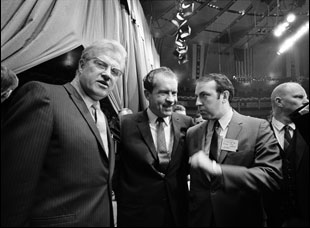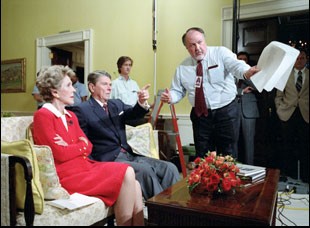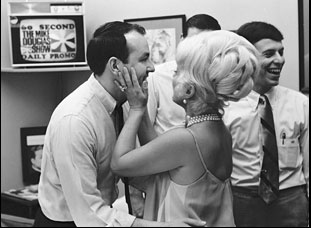At one point in Alexis Bloom’s entertaining and often infuriating new film “Divide and Conquer: The Story of Roger Ailes,” you learn that the man who became the mastermind behind Fox News would’ve likely been satisfied with hosting a show of his own, taking an hour of airtime from the cable network he started with NBC called America’s Talking during the mid-1990s to interview such celebrities as Cyndi Lauper and Roger Clinton. Classmates from his high school in Warren, Ohio remember him as being “Witty, intelligent and mercilessly funny – we all wanted to be like [him],” suggesting that he was every bit as qualified to be on-air talent as anyone he ever hired or advised, going as far back as “The Mike Douglas Show” where he worked his way up from getting sandwiches for guests to becoming an executive producer. But when the network was rebranded as MSNBC, he would become too obsessed with building a competitor to it to appear much on camera anymore.
Throughout “Divide and Conquer,” it is these minor forks in the road that Bloom illustrates so clearly that make you wonder how differently America might look if only Ailes wasn’t always avenging one slight or another, continually showing how big he was and how very small he could be. From his time on “Mike Douglas” where he snagged a job as an associate producer right out from under someone with more seniority to ultimately taking ownership of the local newspaper in his home of Cold Spring with the aim of controlling the politics in the region, Ailes could be counted on to be at least ten steps ahead in any given situation of those impacted by his actions, but one foot always firmly planted in some resentment that would inspire him to take action in the first place, whether it was becoming a Republican when he believed it was unions that forced companies to move out of Warren or stifling one career or another once he became a top operative in the party when people didn’t do what he wanted, ultimately drifting into the illegal and immoral as he saw his considerable power as leverage over the women who worked under him.
“Divide and Conquer” makes a compelling case that the culture that Ailes cultivated within his own operation over decades, first in advising political campaigns from the days of Nixon to eventually serving as the CEO of Fox News, spilled over into mainstream of America and as clip after clip shows his genius for engrossing television, the film shows how his willingness to be gross, appealing to the most base instincts of the general public, as well as in his private affairs often rewarded him before becoming his undoing. While in Los Angeles for the film’s premiere at AFI Fest, Bloom spoke about how she became intrigued with telling the story of Ailes and how his death in the middle of production opened new avenues for the film, in addition to the challenge of licensing clips and securing a remarkable interview with the crisis communications team that advised Ailes in his sexual harassment suits.
To some extent, we live in his world, whether we like it or not, so I approached it from that angle to best try and understand this ambiguous, somewhat remote figure who has a hand in everything, certainly in the rise of the right and this particular strand of conservatism. The Tea Party was born on Fox News and he’s personally fascinating, where he comes from and his humble beginnings and the accumulation of power.
It was particularly impressive to me how you went about the interviews you include – you seem to go for quality over quantity and really give those you talk to the time to share their stories. Was that always in mind?
I just try and find people who can shed light on the man. You have to have known him well. There’s one exception – the crisis communications people came in at the end of his life and didn’t know him throughout, but they were in a sufficiently interesting predicament that they were worth interviewing. Otherwise, you choose people who were in the room, who had thought about him, and have seen many sides of him and had some kind of understanding of how the different parts of him interconnect. They’re not big names necessarily, but I’m less inclined towards that than I am attracted by people who have fascinating stories to tell. They’re all warm, interesting people who knew him well and illustrated some aspect of his life that I thought was very telling.
How did you find out Karen Kessler and Warren Cooper, the crisis counselors, would be willing to go on the record?
I didn’t know they’d be willing. They were mentioned in passing, like one line in a Vanity Fair article, but that person had not really interviewed them. They stayed out of the press, but when we were doing follow-ups, I was like, “Well, what about these people? Let’s call them up.” So we had a fascinating off-the-record conversation, but then they said, “Obviously, we can’t go on camera and we’re not going on the record.” So it took a long time – it took a year – of discussions before they agreed to be interviewed.

Yeah, there were people in the film who wouldn’t have spoken had he been alive. He was a menacing figure and litigious. But in some ways, his death was a great disappointment for us filmmaking-wise because we really wanted to interview him. I hadn’t given up hope that we would.
Did it make licensing clips any easier?
It’s bloody difficult. You try to get clips from Fox News. [laughs] It’s impossible and they almost don’t license them, so you have to find your material in a wide variety of different ways, [whether it’s] online or from different people who worked there who might’ve had or kept tapes or this anchor or that producer. It’s a really laborious, time-consuming task and we had the most amazing researcher, Gabriela Alcalde, who will probably one day give me a job. She spent a year doing this.
Was there any piece of footage that became a Holy Grail?
There was stuff we tried to get, but didn’t get. There was a wonderful piece of archive of Roger on “The David Frost Show” in ’68. It was in the film for a long time and Roger was so revealing in it, talking with Joe McGinniss about how you elect a president. Joe McGinniss called him out for stacking the odds in Nixon’s favor [during a debate], having an audience of so-called ordinary people there, but of course Roger had pre-selected them all and there wasn’t a critic there. And when he’s totally called out on it, he’s shifty and he’s sweating, but David Frost’s son said at the last minute, “No, you can’t use that. I might one day want to make a film about my father and I might want to use this clip, so sorry,” and he pulled it. So things like that happen to you. You’re subject to the idiosyncrasy of the people who own this material. We [also] heard of a tape where Roger was unhappy with someone and had left a voicemail and used up the tape screaming at a person and cursing him out. But then we couldn’t find the tape. The person’s like, “Well, it’s in my attic somewhere and I don’t know whether we can find it,” so you’re haunted by the stuff you don’t get, not by the stuff you do.

Yeah, Cold Spring is such an important story because Roger was almost professionally engaged in conflict at Fox and was paid for it, but what did he do on the weekends when he was back at his home at his country house? He bought the local paper, pitted one citizen against the other and bullied people, generally trying to control the town, and I thought it was this fascinating, ordinary every day story that we could use to illuminate bigger points about Roger.
With Trump in the White House and the #metoo movement ongoing as you’re in production, did it influence at all what you ultimately wanted to convey with this?
The story remained the story in some sense, but your disbelief at the irony of the situation grew. The world that Roger created just became more exaggerated and more painful as the film progressed, and my sense of urgency to get the story out became greater because it became clear that the king is dead. Long live the king. Roger was dead, but his world was very much alive and a new king had replaced him. And it feels good to get Roger Ailes out into the world [because] it’s a story that needs to be told. We need to understand the ambiguity that resides in people who create our political structures and we need to deal with the division in America and understand it for what it is. I think that Roger’s story helps us understand this moment in contemporary life.
“Divide and Conquer: The Story of Roger Ailes” opens on December 7th in limited release, including Los Angeles at the Nuart Theater and in New York at the Landmark at 57 West. A full list of cities and dates is here.





